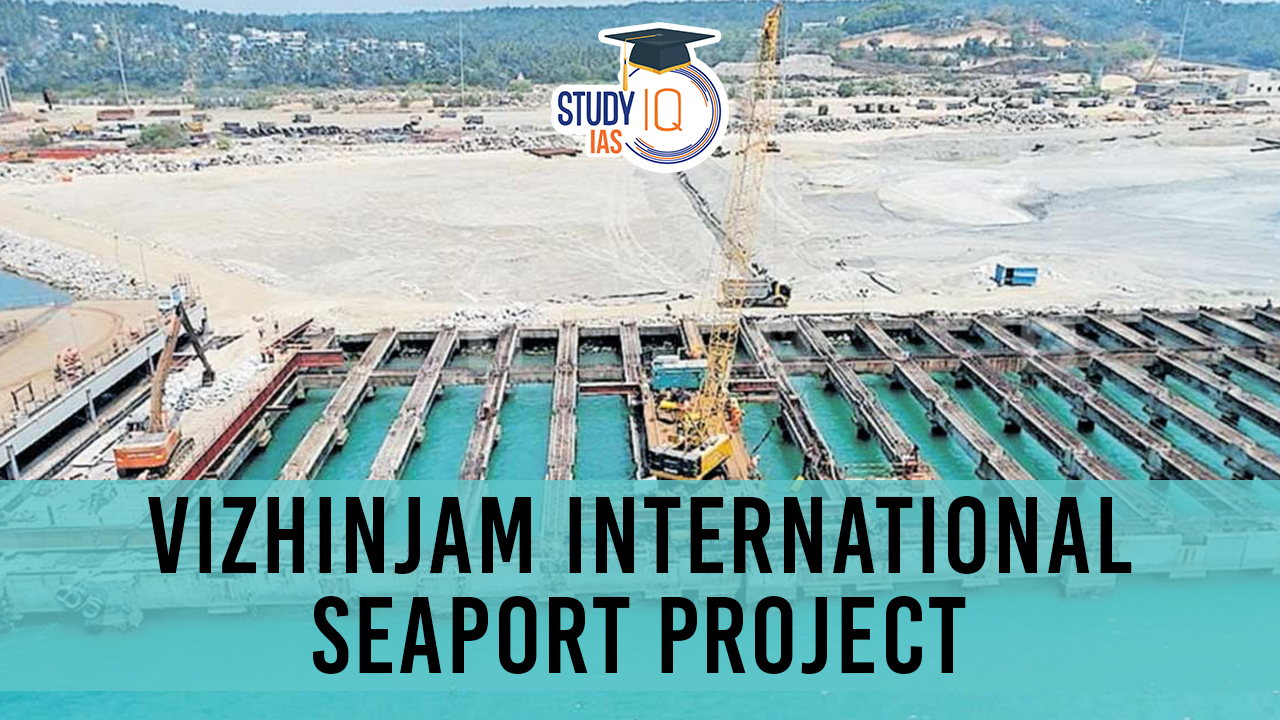Table of Contents
Context: Prime Minister Narendra Modi officially launched the Vizhinjam International Seaport in Kerala’s Thiruvananthapuram. The Vizhinjam seaport has been completed at an estimated Rs 8,867 crore. The Prime Minister inaugurally commissioned the first phase of the complex in the presence of Kerala Chief Minister Pinarayi Vijayan, Adani Group chairman Gautam Adani and Thiruvananthapuram Congress MP Shashi Tharoor.
Recently, one of the world’s largest and most fuel-efficient container ships, MSC Türkiye, docked at Vizhinjam International Seaport.
Vizhinjam International Seaport Project
- Vizhinjam International Seaport is India’s first deepwater transhipment port located in Vizhinjam (near Thiruvananthapuram), Kerala.
- Deepwater Port: Manmade structures that are used as ports or terminals to transport, store or handle oil and natural gas.
- Transhipment Port: It is a transit hub where cargo is transferred from one ship to another while in transit to its final destination.
- Vizhinjam International Seaport is built on a design, build, finance, operate and transfer (DBFOT) model.
- DBFOT model is a Public-Private Partnership (PPP) model under which a private partner is responsible for:
- Designing the project
- Building the project
- Financing the project
- Operating the project during the contracted period.
- Transferring the project back to the public sector after the end of the contract period.
- DBFOT model is a Public-Private Partnership (PPP) model under which a private partner is responsible for:
- There are 12 Major Ports in India: Chennai, Cochin, Deendayal (Kandla), Jawaharlal Nehru (Nhava Sheva), Kolkata, Mormugao, Mumbai, New Mangalore, Paradip, V. O. Chidambaranar (Tuticorin), Visakhapatnam and Kamarajar Port Limited.
- Major Port at Vadhavan, Palghar District, Maharashtra is under construction.
India’s First Deepwater Transhipment Port: Vizhinjam Project
India’s first deepwater transhipment port is the Vizhinjam International Seaport Project, under construction in Vizhinjam, Kerala. It is expected to be operational by December 2024. The port will create thousands of jobs and boost the economy of Kerala and India as a whole.
The Vizhinjam International Seaport Project is a significant undertaking that will have a major impact on the Indian economy and the global maritime landscape. Once completed, the port will be one of the largest and most modern in the world and will serve as a major hub for transhipment of cargo in the region.
What is a Transshipment Deepwater Seaport?
A transhipment deepwater seaport is a port that is specifically designed to handle large container ships. These ports are typically located in deep water, which allows them to accommodate the largest container ships in the world.
Transhipment deepwater seaports play an important role in the global economy by serving as hubs for the transfer of cargo between different ships. This allows shipping companies to save money on fuel and operating costs, and it also helps to reduce the time it takes for cargo to be transported around the world.
We’re now on WhatsApp. Click to Join
Major Transshipment Deepwater Seaports in the World
Some of the major transhipment deepwater seaports in the world include:
- Singapore
- Shenzhen, China
- Ningbo, China
- Shanghai, China
- Busan, South Korea
- Rotterdam, Netherlands
- Antwerp, Belgium
- Hamburg, Germany
- Jebel Ali, United Arab Emirates
- Long Beach, California, USA
- Los Angeles, California, USA
Read More: Indian Army’s Project UDBHAV
Phases of Vizhinjam International Seaport Project
The Vizhinjam International Seaport Project is expected to be completed in three phases. The first phase will have a capacity of 1 million twenty-foot equivalent units (TEUs), with the potential to expand to 6.2 million TEUs in the future. The first phase of the project is expected to be completed by December 2024, with the remaining phases to be completed in the next few years.
The Vizhinjam port will create thousands of jobs and will boost trade and commerce in the region. The Vizhinjam International Seaport Project is being developed in three phases:
Phase 1
- Construction of two breakwaters with a total length of 3,180 meters
- Construction of a harbour basin and wharfs
- Development of a container terminal with a capacity of 1 million TEUs
Phase 2
- Construction of two additional breakwaters with a total length of 1,640 meters
- Development of a cruise terminal with two berths
- Development of a liquid bulk terminal
Phase 3
- Development of additional container terminals with a capacity of 5.2 million TEUs
Why India Needs a Deepwater Container Transhipment Port?
India has 12 major ports, but it lacks the infrastructure to handle ultra-large container ships. As a result, nearly 75% of India’s transhipment cargo is handled at ports outside of India, mainly in Colombo, Singapore, and Klang. In 2021-22, India’s total transhipment cargo was about 4.6 million TEUs, of which about 4.2 million TEUs were handled outside of India. Developing a port into a transhipment hub would have many benefits, including:
- Saving foreign exchange
- Attracting foreign direct investment
- Increasing economic activity at other Indian ports
- Developing related logistics infrastructure
- Creating jobs
- Improving operational and logistical efficiencies
- Increasing revenue share
Significance of Vizhinjam International Seaport Project
The Vizhinjam International Seaport Project is a significant undertaking that is expected to have a major impact on the Indian economy and the global maritime landscape. Once completed, the port will be one of the largest and most modern in the world and will serve as a major hub for transhipment of cargo in the region. Here are some of the key significances of the Vizhinjam International Seaport Project:
- Vizhinjam International Seaport is India’s first deepwater transhipment port. This means that it will be able to accommodate the largest container ships in the world, which will allow India to compete more effectively in the global shipping market.
- The Vizhinjam port is located in a strategic location on the southwestern coast of India. This gives it easy access to major shipping routes between Europe, Asia, and the Middle East.
- The port is being developed as a multi-purpose port, which means that it will be able to handle a variety of cargo types, including containers, bulk cargo, and cruise ships.
- The port is expected to generate a significant amount of economic activity for the state of Kerala and for India as a whole. It is estimated that the port will create over 100,000 jobs and will generate over $10 billion in annual economic activity.
Benefits of Vizhinjam International Seaport Project
Here are some of the specific benefits of the Vizhinjam International Seaport Project:
- It will reduce the cost of logistics and make Indian exports more competitive.
- It will make India a major hub for transhipment of cargo in the region.
- It will improve India’s connectivity with the rest of the world.
- It will promote tourism and development in Kerala.
- It will create thousands of jobs and boost the economy of Kerala and India as a whole.
Why Vizhinjam?
Here are some of the reasons why Vizhinjam is a good location for a deepwater container transhipment port:
| Reason | Details |
| Strategic Location |
|
| Naturally Advantage |
|
| Transshipment Hub |
|
| India’s Port Sector |
|
| UPSC PYQ |
Consider the following pairs: (2023)
How many of the above pairs are correctly matched?
Answer: B Largest container port of India: Jawaharlal Nehru Port (Nhava Seva), Maharashtra |


 Places in News for UPSC 2026 for Prelims...
Places in News for UPSC 2026 for Prelims...
 Lake Natron: Location, Features, Wildlif...
Lake Natron: Location, Features, Wildlif...
 Erra Matti Dibbalu Added to UNESCO Tenta...
Erra Matti Dibbalu Added to UNESCO Tenta...

























